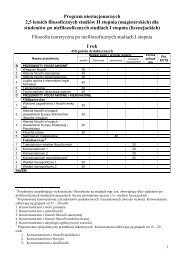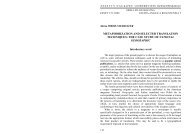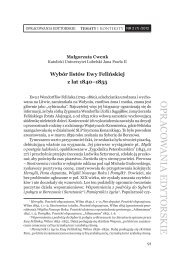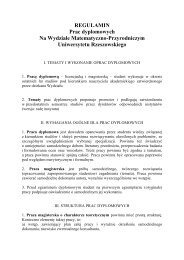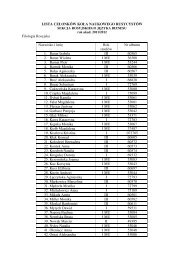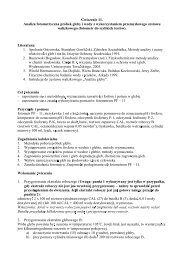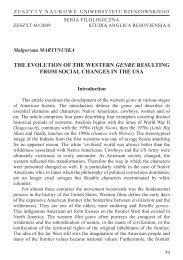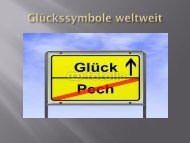reasoning in quadratic equations with one unknown - Cerme 7
reasoning in quadratic equations with one unknown - Cerme 7
reasoning in quadratic equations with one unknown - Cerme 7
Create successful ePaper yourself
Turn your PDF publications into a flip-book with our unique Google optimized e-Paper software.
StatementsQuestion 7The solution of the<strong>quadratic</strong> equation“2 x 2 =3x”is given <strong>in</strong> the follow<strong>in</strong>g;Accord<strong>in</strong>g to you, is thissolution correct or not?Expla<strong>in</strong> your answer <strong>with</strong>its reasons?Solution:I. step 2 x 2 =3xII. step 2∙x∙x=3∙xIII. step 2∙x =3IV. step x= 3/2Ç.K = {3/2}Students’ types of responses <strong>with</strong> their <strong>reason<strong>in</strong>g</strong>I. II. III. IV.“The answer isWrong”Because 3x mustbe carried the leftside of theequation andequalized the 0.Then,2 x 2 =3x2 x 2 - 3x=0x∙(2x-3)=0x=0, x=3/2.“Theanswer isRight”Thesolution isright;however, itmust beadded 0 tothe solutionset.“The answerRight”Because whenwe substitutethe value forx, the equationis satisfied.“The answer isRight”2 x 2 =3x and x 2 isopened.2∙x∙x=3∙xYes the x issimplified.2x=3 so x=3/2.Table 3: Common examples of students’ types of responses <strong>with</strong> their <strong>reason<strong>in</strong>g</strong> forquestion 7.In statement I (see Table 3), students stated that the answer was correct. Theyexpla<strong>in</strong>ed an appropriate procedure required for solv<strong>in</strong>g the equation. S<strong>in</strong>ce theymemorized the rule <strong>with</strong>out its reasons, they could only exhibit how the proceduremust be worked. In statement II, on the other hand, students were aware that the rootsof the equation were 0 and 3/2. However, they did not recognize that when wassimultaneously canceled from both sides, the root 0 disappeared. Furthermore, <strong>in</strong>statement III, the explanation for solution was just based on the substitution method.In statement IV, students <strong>in</strong>correctly stated that the answer was right. Like <strong>in</strong>statement II, students were not aware of the miss<strong>in</strong>g root 0 when cancel<strong>in</strong>g an <strong>in</strong> theequationDISCUSSIONThe results <strong>in</strong>dicate that most of the students used the factorization technique to solve<strong>quadratic</strong> <strong>equations</strong>. This result supports Bosse and Nandakumar (2005), whoclaimed that a large percentage of the students preferred to apply the factorizationtechniques to f<strong>in</strong>d the solutions of <strong>quadratic</strong> <strong>equations</strong>. Also, <strong>in</strong> parallel <strong>with</strong> theresults of Bossé and Nandakumar (2005) and Kotsopoulos (2007), the result of thisstudy revealed that factor<strong>in</strong>g the <strong>quadratic</strong> <strong>equations</strong> was challeng<strong>in</strong>g when they werepresented to students <strong>in</strong> non-standard forms and structures. After look<strong>in</strong>g at theexamples of students’ solutions (see Figures 1, 2, and 3), it can be said that thestudents knew some rules (or procedures) related to solv<strong>in</strong>g <strong>quadratic</strong>s. However,they tried to apply these rules th<strong>in</strong>k<strong>in</strong>g about neither why they did so, nor whether ifwhat they were do<strong>in</strong>g was mathematically correct. These results give some cluesabout students’ <strong>in</strong>strumental understand<strong>in</strong>g of solv<strong>in</strong>g <strong>quadratic</strong> <strong>equations</strong> <strong>with</strong> <strong>one</strong><strong>unknown</strong>. However, to make an exact judgment about students’ relational or7




